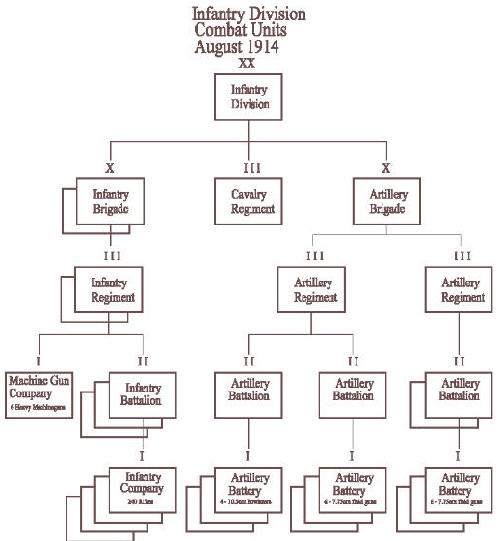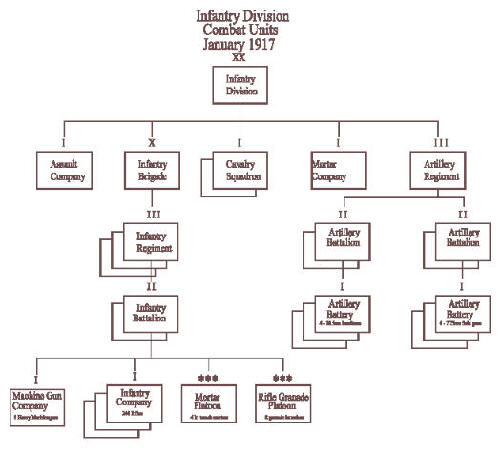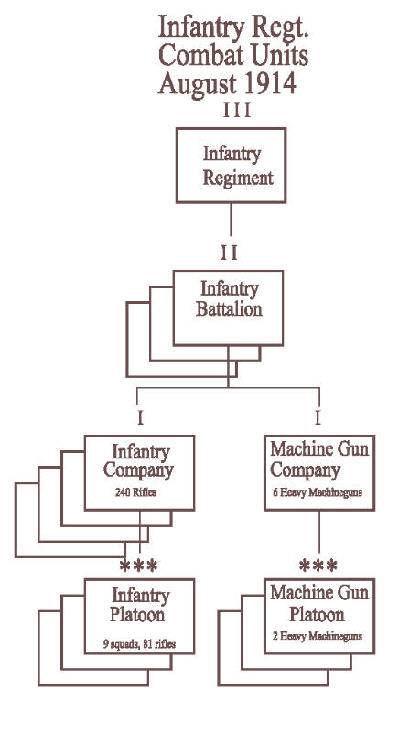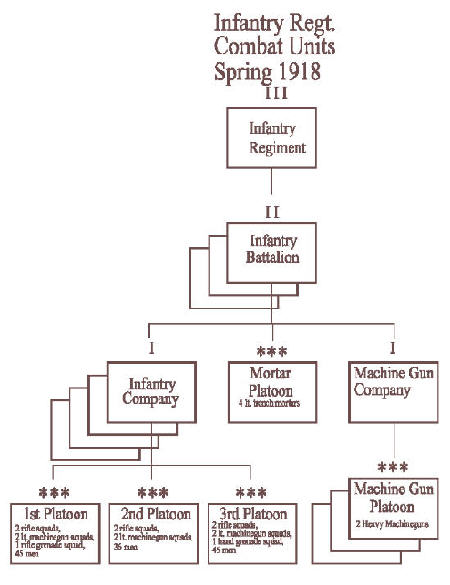
| Back | Special | Library | Search | Home | Help |
Reorganization of the German Army, 1914-1918
 |
| Artist's Impression of an assault during the Battle of Verdun, 1916 |
Contributed by

Ralph Reiley (Reileys@worldnet.att.net)
Reorganization of 1915: A squad of Saxon soldiers in a group photo, circa August 1914. These soldiers are in full marching gear, about 60 pounds of equipment. Note the overcoat and shelter quarter strapped to the top and sides of the bulky cowhide back pack.In March and April of 1915 the infantry divisions were reduced in size from 4 regiments to 3. In this reorganization, 19 new regiments were created, without increasing the number of men in uniform. The nature of the war also saw a change in the number and types of combat units needed for the war effort. See chart below for a comparison of the composition of the army at the beginning and end of the war:  Reorganization of 1917: German troops in training for the Spring 1918 offensive, note the use of assault packs in place of the bulky cowhide back pack. The assault pack was made up of rolling the overcoat and shelter quarter around the messkit, and was much preferred to the heavy back pack. 
To make up for the smaller number of riflemen in a rifle company, new weapons were incorporated into the makeup of the platoons in the rifle company. In 1914, each rifle company was supported by a heavy machine gun platoon. After 1915, light machine guns were also incorporated into rifle platoons, and several types of grenades were issued in large numbers. At the company level of command, hand grenade and rifle grenade sections were incorporated. At the Regimental level of command spigot grenade launchers, light trench mortars and flamethrower sections were added. Initially, pioneer specialists attached to rifle companies, at divisional and corps command manned these weapons. These new weapons and the change in tactics greatly increased the firepower available to a rifle company, offsetting the reduced number of men. See charts below for comparison of Combat units for a 1914 and 1918 infantry regiment:   Changes in Tactics and Organization: German troops in training for the Spring 1918 offensive, note the number of hand grenades in use, and lack of rifles with fixed bayonets.Another aspect of advancing on the World War 1 battlefield had to do with supply. As the attacker moved forward into the defender's rear area, supplies and reinforcements were left further and further behind. In contrast, the defender was moving closer to their sources of supply and reinforcement. The attacker had to transport artillery, reinforcements, and supplies over ground made impassible from the long preliminary artillery barrage. This lack of communication, lead to the development of the regiment as an independent attacking force. If an enemy pillbox was holding up an advance, light trench mortars or rifle grenades could be brought to bear to deal with the problem directly in place of having to wait several hours to communicate with headquarters to call in artillery support. Along with the changes in the composition of the rifle company and rifle regiment, new tactics in using artillery, machine gun units, light infantry artillery units, assault troops, poison gas, tanks and ground attack aircraft were developed. A full description of these tactics and weapons is beyond the scope of this short article. Starting with the Verdun campaign of 1916, the Germans began introducing new tactics to achieve a breakthrough. The long drawn out artillery barrages were replaced by short but very intense artillery barrage mixed with poison gas, followed by an immediate infantry attack. The artillery then fired on the enemy's artillery batteries, as well as the rear and flanks of the attack area to prevent the enemy from moving in reinforcements. Infantry no longer advanced in long waves of men, but moved forward in small groups, infiltrating into the enemy's rear areas. Flamethrowers, grenades, rifle grenades, and light trench mortars on mobile mounts that moved with the assault troops overpowered the defender's strong points. A well-entrenched strong point could also be by-passed and left for later when the field artillery could be brought forward. In 1916, the Allied armies introduced tanks to the battlefield. The German Army was slow to develop tanks of their own. Only 20 of the bulky A7V's made it to front line service. The Germans relied mostly on British tanks captured during the Battle of Cambrai in 1917. They were quick to introduce new anti-tank detachments; using a combination of newly designed weapons, like the 11mm Mauser bolt-action rifle, a 37mm anti-tank gun, and existing 77mm field guns located in front line positions. By the spring of 1918, the Germans were ready for one last major offensive to break the deadlock, and end the war in their favor. The army was reorganized and trained with new weapons and tactics. It was also reinforced with units freed from the Eastern Front. The German Spring Offensives of 1918 nearly broke the allied line. But in the end, they ran out of guns, supplies and men and failed to break the Allied line. The Allied armies recovered, and in the summer of 1918, began their own offensive. The Allies had also reorganized their armies and trained using similar tactics as the Germans were using, and steadily drove the Germans back, until the Armistice of November 11, 1918.  MG08/15 Light Machine gun crew in training, circa 1918. Note blank adaptor on gun muzzle. The soldiers on the far left and right are holding ammunition boxes. The soldier 2nd from right is holding a water supply container, which would be attached to steam condensing hose seen at the top rear of the water jacket on the gun. The soldier standing is the unterofficier (corporal), and commander of the squad. A grenatenwurfer and crew. This weapon weighed 90 pounds, and fired a 4-5 lb. grenade to a range of 50-350 yards. A light minnenwurfer and crew, 1918. This light mortar fired a 7.85 cm shell to a range of 1300 yards. It is mounted on the new model carriage that allowed the gun to function as a trench mortar or a light infantry field gun. It could be pulled into action by 4. An artist's impression of troops crossing the Marne River on a pontoon bridge during the Spring 1918 offensive
Verdun, 1916, Two soldiers with the model 1916 Kleif Flammenwurfer. This weapon had an effective range of 25 yards, and carried 16 gallons of fuel.For Further Reading
© 2006 Ralph Reiley - All rights reserved |